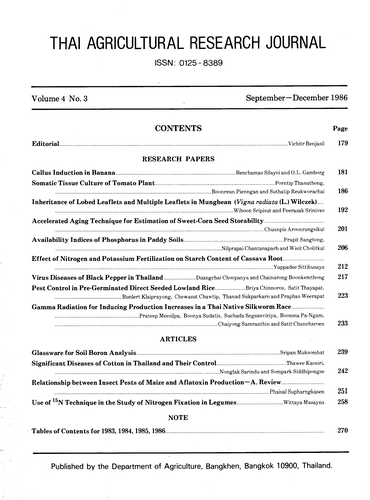Callus Induction in Banana
Abstract
Greater plantlet variability is obtained from culture based on callus induction and protoplast procedures, relative to the cultlure of meristem and shoot tips. This study aimed to determine the optimal growth regulator concentrations for the induction of callus from banana explants. Leaf blades, petioles and root material were cut into segments and cultured in MS and B5 media with treatments of 1,2,5 and 5 ppm of 2,4-D,2,4,5-T, IAA, NAA and Dicamba. Superimposed on these treatments was BA in concentrations of 0.5, 2 and 5 ppm. All cultures were intiated under light conditions of about 2,000 lux and a temperature of 26 C. Callus induction was observed after one month. Calli occurred in 50 percent of the leaf blade cultures, while petiole and root cultures turns black and died.
The most suitable media for callus induction was MS with NAA or BA. A rate of 50 percent induction was achieved in MS with 1 ppm NAA + 5 ppm BA, 2.5 ppm NAA + 2 ppm BA, 2.5 ppm NAA + 5 ppm BA, 5 ppm NAA + 5 ppm BA; a 20 percent callus induction rate was obtained in the MS media with 1 ppm NAA + 2 ppm BA, and 5 ppm NAA + 2 ppm BA.
When the calli were transferred to regeneration media, 30 ercent were regenerated in teh MS media with 2.5 ppm BA. When the established shoots were transferred to MS media, all rooted.
Downloads
Published
How to Cite
Issue
Section
License
Thai Agricultural Research Journal



